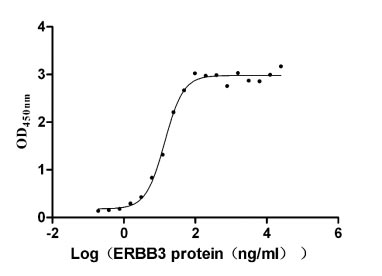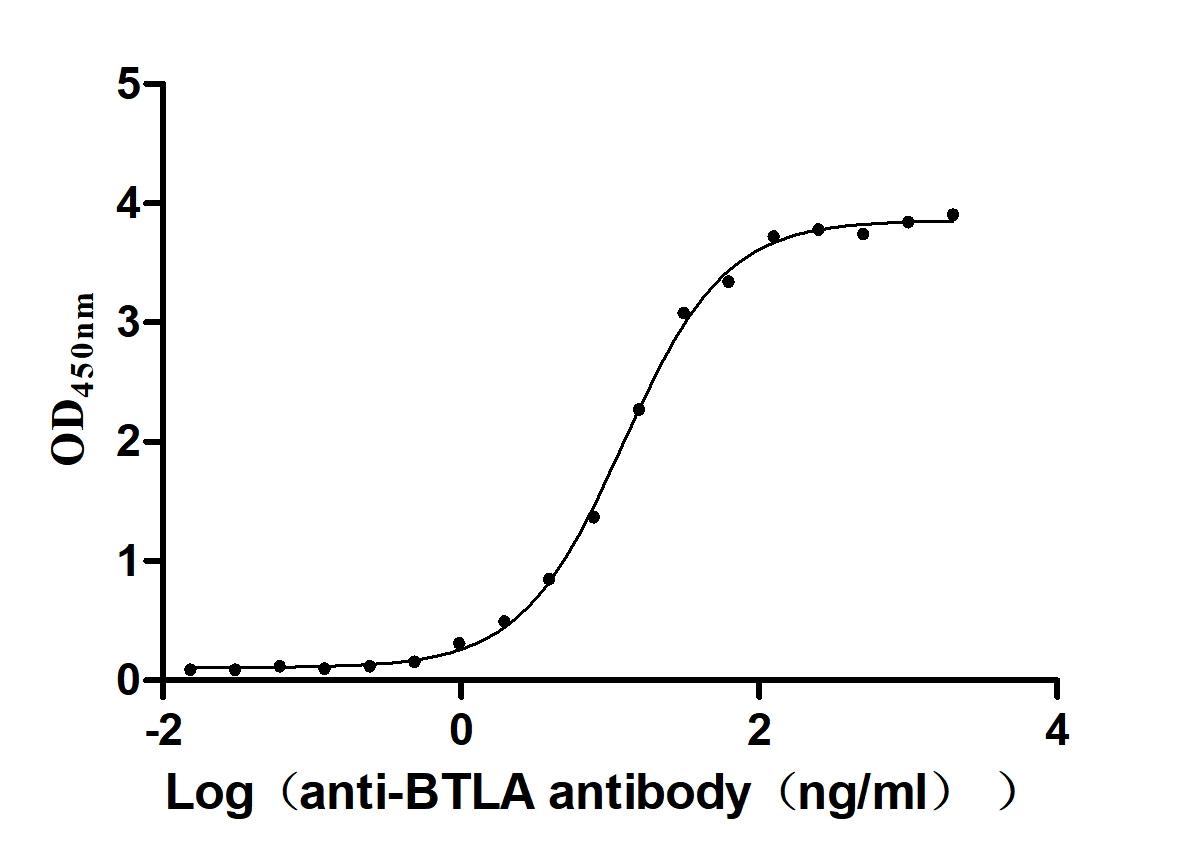Recombinant Mouse Mitochondrial peptide methionine sulfoxide reductase (Msra)
-
中文名称:小鼠Msra重组蛋白
-
货号:CSB-YP880509MO
-
规格:
-
来源:Yeast
-
其他:
-
中文名称:小鼠Msra重组蛋白
-
货号:CSB-EP880509MO
-
规格:
-
来源:E.coli
-
其他:
-
中文名称:小鼠Msra重组蛋白
-
货号:CSB-EP880509MO-B
-
规格:
-
来源:E.coli
-
共轭:Avi-tag Biotinylated
E. coli biotin ligase (BirA) is highly specific in covalently attaching biotin to the 15 amino acid AviTag peptide. This recombinant protein was biotinylated in vivo by AviTag-BirA technology, which method is BriA catalyzes amide linkage between the biotin and the specific lysine of the AviTag.
-
其他:
-
中文名称:小鼠Msra重组蛋白
-
货号:CSB-BP880509MO
-
规格:
-
来源:Baculovirus
-
其他:
-
中文名称:小鼠Msra重组蛋白
-
货号:CSB-MP880509MO
-
规格:
-
来源:Mammalian cell
-
其他:
产品详情
-
纯度:>85% (SDS-PAGE)
-
基因名:Msra
-
Uniprot No.:
-
别名:Msra; Mitochondrial peptide methionine sulfoxide reductase; EC 1.8.4.11; Peptide-methionine; S)-S-oxide reductase; Peptide Met(O) reductase; Protein-methionine-S-oxide reductase; PMSR
-
种属:Mus musculus (Mouse)
-
蛋白长度:full length protein
-
表达区域:21-233
-
氨基酸序列MGDSASKVIS AEEALPGRTE PIPVTAKHHV SGNRTVEPFP EGTQMAVFGM GCFWGAERKF WVLKGVYSTQ VGFAGGHTRN PTYKEVCSEK TGHAEVVRVV YRPEHISFEE LLKVFWENHD PTQGMRQGND FGTQYRSAVY PTSAVQMEAA LRSKEEYQKV LSKHNFGPIT TDIREGQVFY YAEDYHQQYL SKNPDGYCGL GGTGVSCPMA IKK
-
蛋白标签:Tag type will be determined during the manufacturing process.
The tag type will be determined during production process. If you have specified tag type, please tell us and we will develop the specified tag preferentially. -
产品提供形式:Lyophilized powder
Note: We will preferentially ship the format that we have in stock, however, if you have any special requirement for the format, please remark your requirement when placing the order, we will prepare according to your demand. -
复溶:We recommend that this vial be briefly centrifuged prior to opening to bring the contents to the bottom. Please reconstitute protein in deionized sterile water to a concentration of 0.1-1.0 mg/mL.We recommend to add 5-50% of glycerol (final concentration) and aliquot for long-term storage at -20℃/-80℃. Our default final concentration of glycerol is 50%. Customers could use it as reference.
-
储存条件:Store at -20°C/-80°C upon receipt, aliquoting is necessary for mutiple use. Avoid repeated freeze-thaw cycles.
-
保质期:The shelf life is related to many factors, storage state, buffer ingredients, storage temperature and the stability of the protein itself.
Generally, the shelf life of liquid form is 6 months at -20°C/-80°C. The shelf life of lyophilized form is 12 months at -20°C/-80°C. -
货期:Delivery time may differ from different purchasing way or location, please kindly consult your local distributors for specific delivery time.Note: All of our proteins are default shipped with normal blue ice packs, if you request to ship with dry ice, please communicate with us in advance and extra fees will be charged.
-
注意事项:Repeated freezing and thawing is not recommended. Store working aliquots at 4°C for up to one week.
-
Datasheet :Please contact us to get it.
靶点详情
-
功能:Has an important function as a repair enzyme for proteins that have been inactivated by oxidation. Catalyzes the reversible oxidation-reduction of methionine sulfoxide in proteins to methionine.
-
基因功能参考文献:
- Our findings demonstrate that reversal of methionine oxidation is required for maintenance of cellular homeostasis in the absence of increased oxidative stress. These data provide the first link between autophagy and activation of Nrf2 in the setting of MsrA deletion PMID: 29649787
- Study shows that cisplatin induces methionine oxidation, oxidative stress, mitochondrial damage, apoptosis, and necrosis, and that MsrA gene deletion accelerates these cisplatin-induced damages. This indicates that MsrA protects kidney against cisplatin-induced acute kidney injury. PMID: 28158949
- MsrA protects against lipopolysaccharide-induced septic shock, and negatively regulates proinflammatory responses via inhibition of the ROS-MAPK-NF-kappaB signaling pathways. PMID: 28803836
- Collectively, our results suggest that MsrA protects hepatocytes from APAP-induced cytotoxicity through the modulation of TXNRD1 expression. PMID: 28442342
- results demonstrate that MsrA protects the liver from APAP-induced toxicity. The data provided herein constitute the first in vivo evidence of the involvement of MsrA in hepatic function under APAP challenge PMID: 28104395
- Results suggest that lower MsrA activity modifies Amyloid-beta solubility properties and causes mitochondrial dysfunction in a mouse model of Alzheimer's disease. PMID: 26786779
- MsrA acts as a negative regulator of vascular smooth muscle cell proliferation and neointimal hyperplasia after vascular injury through control of the Ras/Raf/ERK1/ERK2 signaling pathway. PMID: 26449752
- ARD1 has a crucial role in the cellular response to oxidative stress as a bona fide regulator of MSRA. PMID: 25341044
- These results suggest that COMT activity may be reduced by methionine oxidation, and point to Msr as a key molecular determinant for the modulation of COMT activity in the brain. PMID: 24735585
- The MsrA and protein oxidation play a role in the regulation of glucose homeostasis. PMID: 23089224
- MsrA protects the kidney against I/R injury, and that this protection is associated with reduced oxidative stress and inflammatory responses. PMID: 22657153
- MsrA overexpression in MsrA-depleted cells led to the reduction of increased HO-1 expression, and suppressed nuclear accumulation of Nrf2. PMID: 23036869
- Mammalian and yeast Msra reduced free methionine sulfoxide much more efficiently than Msrb. PMID: 22867795
- Characterization and solution structure of mouse myristoylated methionine sulfoxide reductase A. PMID: 22661718
- A low pKa cysteine at the active site of mouse methionine sulfoxide reductase A. PMID: 22661719
- The data suggest that MsrA is a regulator of cell growth that mediates the p53-p21 pathway. PMID: 22086179
- MsrA-/- knockout mice maintain a larger brain dopamine reserve pool than wild-type control mice, a difference not likely caused by altered dopamine transporter expression. PMID: 21219974
- We conclude that cytosolic MsrA protects the heart from ischemia-reperfusion damage PMID: 21841012
- A c-terminal truncated form of MsrA was cloned from mouse embryonic stem cells. The truncated protein shows a different subcellular localization and pattern of expression response to anoxia/reoxygenation treatment on the stem cells. PMID: 21696616
- Anoxia, acidosis, and intergenic interactions selectively regulate methionine sulfoxide reductase transcriptions in mouse embryonic stem cells PMID: 20872796
- Results indicate that MsrA plays an important role in cellular defenses against oxidative stress in embryonic stem cells. PMID: 20506347
- the lack of MsrA in cardiac myocytes reduces myocardial cell's capability against stress stimulations resulting in a cellular dysfunction in the heart. PMID: 20971073
- Ablation of methionine sulfoxide reductase can affect dopamine signaling through altering dopamine D(2)-receptor physiology and may be related to symptoms associated with neurological disorders and diseases. PMID: 20374422
- Dual sites of protein initiation control the localization and myristoylation of methionine sulfoxide reductase A PMID: 20368336
- Data show that methionine sulfoxide reductase (Msr)B1, but not MsrA, is the major methionine sulfoxide reductase in liver of mice and it is among the proteins that are most easily regulated by dietary selenium. PMID: 19769460
- Methionine oxidation of alpha-crystallin in combination with loss of MsrA repair causes loss of alpha-crystallin chaperone function. PMID: 19733220
- msra expression is regulated by (dietary)selenium PMID: 12792026
- Proper structure-function organization of MsrA plays a role in subcellular distribution of this protein in mouse cells. PMID: 15924425
- Moreover, following selenium deficient diet (applied to decrease the expression levels of selenoproteins like MsrB), the latter effect was maintained while the basal levels of thiol decreased in both mouse strains. PMID: 17126812
- It is suggested that a deficiency in MsrA activity fosters oxidative-stress that is manifested by the accumulation of faulty proteins (via methionine oxidation), deposition of aggregated proteins, and premature brain cell death. PMID: 17333008
- Results show MsrA deletion increases light scattering in lenses of mice exposed to hyperbaric oxygen; identifies cyt c as oxidized in the knockout lenses. Also establishes MsrA can restore in vitro activity of cyt c through methionine sulfoxide repair. PMID: 19461988
- MsrA regulates sensitivity to oxidative stress in mice but has no effect on aging, as determined by life span. PMID: 19487311
显示更多
收起更多
-
亚细胞定位:[Isoform 1]: Mitochondrion.; [Isoform 2]: Cytoplasm. Nucleus. Membrane; Lipid-anchor.
-
蛋白家族:MsrA Met sulfoxide reductase family
-
数据库链接:
KEGG: mmu:110265
STRING: 10090.ENSMUSP00000065754
UniGene: Mm.26713
Most popular with customers
-
Recombinant Human Glypican-3 (GPC3) (G537R), partial (Active)
Express system: Mammalian cell
Species: Homo sapiens (Human)
-
Recombinant Human Receptor tyrosine-protein kinase erbB-3 (ERBB3), partial (Active)
Express system: Mammalian cell
Species: Homo sapiens (Human)
-
Recombinant Human Tumor necrosis factor ligand superfamily member 9 (TNFSF9), partial (Active)
Express system: Mammalian cell
Species: Homo sapiens (Human)
-
Recombinant Human Cadherin-17 (CDH17), partial (Active)
Express system: Mammalian cell
Species: Homo sapiens (Human)
-
Recombinant Human Serotransferrin(TF) (Active)
Express system: Mammalian cell
Species: Homo sapiens (Human)
-
Recombinant Human B- and T-lymphocyte attenuator(BTLA), partial (Active)
Express system: Mammalian cell
Species: Homo sapiens (Human)
-
Recombinant Human Gastric inhibitory polypeptide receptor(GIPR),partial (Active)
Express system: Mammalian cell
Species: Homo sapiens (Human)


-AC1.jpg)
















